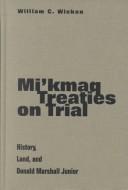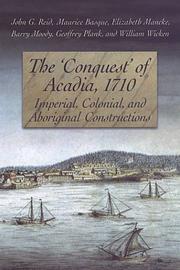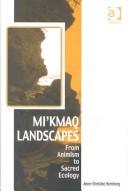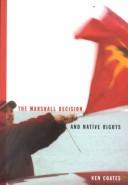| Listing 1 - 10 of 12 | << page >> |
Sort by
|
Book
ISBN: 1280777869 9786613688255 0774817917 Year: 2010 Publisher: Vancouver : UBC Press,
Abstract | Keywords | Export | Availability | Bookmark
 Loading...
Loading...Choose an application
- Reference Manager
- EndNote
- RefWorks (Direct export to RefWorks)
In 1899 the Canadian government passed legislation to replace the appointment of Mi'kmaw leaders and Mi'kmaw political practices with the triennial system, a Euro-Canadian system of democratic band council elections. Officials in Ottawa assumed the federally mandated and supervised system would redefine Mi'kmaw politics. They were wrong. Drawing on reports and correspondence of the Department of Indian Affairs, Martha Walls details the rich life of Mi'kmaw politics between 1899 and 1951. She shows that many Mi'kmaw communities rejected, ignored, or amended federal electoral legislation, while others accepted it only sporadically, not in acquiescence to Ottawa's assimilative project but to meet specific community needs and goals. Compelling and timely, this book supports Aboriginal claims to self-governance and complicates understandings of state power by showing that the Mi'kmaw, rather than succumbing to imposed political models, retained political practices that distinguished them from their Euro-Canadian neighbours.
Mi'kmaq peoples --- Election law --- Legal status, laws, etc. --- Politics and government. --- Government relations.
Book
ISBN: 177112265X 9781771122665 1771122668 9781771122474 1771122471 9781771122658 Year: 2017 Publisher: Waterloo, Ontario, Canada : Wilfrid Laurier University Press,
Abstract | Keywords | Export | Availability | Bookmark
 Loading...
Loading...Choose an application
- Reference Manager
- EndNote
- RefWorks (Direct export to RefWorks)
Both an adventure-laced captivity tale and an impassioned denunciation of the marginalization of Indigenous culture in the face of European colonial expansion, Douglas Smith Huyghue?s Argimou (1847) is the first Canadian novel to describe the fall of eighteenth-century Fort Beauséjour and the expulsion of the Acadians. Its integration of the untamed New Brunswick landscape into the narrative, including a dramatic finale that takes place over the reversing falls in Saint John, intensifies a sense of the heroic proportions of the novel's protagonist, Argimou. Even if read as an escapist romance and captivity tale, Argimou captures for posterity a sense of the Tantramar mists, boundless forests, and majestic waters informing the topographical character of pre-Victorian New Brunswick. Its snapshot of the human suffering occasioned by the 1755 expulsion of the Acadians, and its appeal to Victorian readers to pay attention to the increasingly disenfranchised state of Indigenous peoples, make the novel a valuable contribution to early Canadian fiction. Situating the novel in its eighteenth-century historical and geographical context, the afterword to this new edition foregrounds the author's skilful adaptation of historical-fiction conventions popularized by Sir Walter Scott and additionally highlights his social concern for the fate of Indigenous cultures in nineteenth-century Maritime Canada.
Micmac Indians --- Indian captivities --- Mickmak Indians --- Migmac Indians --- Mi'kmaq Indians --- Mi'kmaw Indians --- Algonquian Indians --- Indians of North America --- Mi'kmaq peoples
Book
ISBN: 0773549099 0773549080 0773549064 9780773549081 9780773549098 9780773549074 0773549072 9780773549067 Year: 2017 Publisher: Montreal, [Canada] : McGill-Queen's University Press,
Abstract | Keywords | Export | Availability | Bookmark
 Loading...
Loading...Choose an application
- Reference Manager
- EndNote
- RefWorks (Direct export to RefWorks)
"The story chronicles the collaborative efforts of Wildcat First Nation community members and North Queens School staff as we collaborate and learn initially through a salmon project based in the community and then through the implementation of a native studies course in the school. Both initiatives reflect our efforts to centre and legitimate Mi'kmaw knowledge in the school." Written in the form of a trickster tale, the book explores the challenges of incorporating Indigenous ways of knowing, doing, and being in education. The research uses Indigenous research methodology to examine, through storytelling, the work of a group of educators and members of a Mi'kmaq community in Nova Scotia whose collaborative projects addressed this challenge. Crow, a central trickster character in the story, embodies the wisdom of Indigenous Elders. The juxtapositioning of Crow and the academic writer, who understands the world through Western epistemology, highlights the convergence of these two worldviews in teaching and learning. Their dialogue demonstrates the need for educators to critically examine their assumptions about the world and to decolonize their thinking in order to participate in Aboriginal education. The narrative is an interweaving of voices from Elders, educators, Mi'kmaq community members and trickster figures that speak to the interconnectivity of all life. A salmon project reinforces the teachings of respect, reciprocity, and responsibility and, in so doing, emphasizes the need for repairing and strengthening relationships with other people and all other life on the land as fundamentally important to the efforts of decolonizing our minds."--
Micmac Indians. --- Micmac Indians --- Mickmak Indians --- Migmac Indians --- Mi'kmaq Indians --- Mi'kmaw Indians --- Algonquian Indians --- Indians of North America --- Education --- Mi'kmaq peoples --- Mi'kmaq. --- Mi'kmaq

ISBN: 1442670215 9781442670211 080200718X 9780802007186 0802076653 9780802076656 Year: 2002 Publisher: Toronto : Abingdon : University of Toronto Press ; Marston,
Abstract | Keywords | Export | Availability | Bookmark
 Loading...
Loading...Choose an application
- Reference Manager
- EndNote
- RefWorks (Direct export to RefWorks)
In 1725-6 the British colonial government of Nova Scotia signed a treaty of friendship and peace with the local Mi'kmaq people. This treaty explicitly acknowledged the co-existence of Mi'kmaq and British law - but much of its meaning stemmed from its complex negotiation, which was influenced by the history of aboriginal-European relations in Acadia prior to 1726. William Wicken argues that after 1749 a more forceful British military presence led officials to re-interpret the treaty in the light of its own interests.From 1994 to 1996, the author was an expert witness for the defence at the Marshall trial, during which the Supreme Court of Canada integrated aboriginal perspectives on treaty-making into current interpretations. Dr Wicken was one of the historians who gathered and presented the historical evidence to the court. This timely and original work intersperses close analysis of the 1726 treaty with discussions of the Marshall case, and shows how the inter-cultural relationships and power dynamics of the past, have shaped both the law and the social climate of the present. The author argues that the treaties must be viewed in their historical context, and that of the oral tradition of Mi'kmaq people, to be properly understood.Current high-profile legal cases involving aboriginal rights lend this work a special significance among the legal and academic communities, where it is destined to spark debate. It is of particular relevance to history and native studies students.
Micmac Indians --- Indians of North America --- Mickmak Indians --- Migmac Indians --- Mi'kmaq Indians --- Mi'kmaw Indians --- Algonquian Indians --- Mi'kmaq peoples --- Marshall, Donald, --- Trials, litigation, etc. --- Marshall, Donald --- Mi'kmaq --- Indigenous peoples
Book
ISBN: 0776627783 0776627775 9780776627786 9780776627779 Year: 2019 Publisher: Ottawa, Ontario : Baltimore, Md. : University of Ottawa Press, Project MUSE,
Abstract | Keywords | Export | Availability | Bookmark
 Loading...
Loading...Choose an application
- Reference Manager
- EndNote
- RefWorks (Direct export to RefWorks)
"The book describes in detail the findings of five seasons (2008-2012) of survey and excavation in Port Joli, and ten years of laboratory analysis, undertaken by the Canadian Museum of History, in collaboration with Acadia First Nation. It also incorporates data recovered from previous archaeological work conducted in Port Joli by Erskine, Raddall, Millard, and others, providing a complete synthesis of one of Nova Scotia’s richest Indigenous archaeological records. Reviving the art of a traditional archaeology 'site monograph', the work provides a complete presentation of all the archaeological information recovered, including full-colour artifact plates, technical drawings, profiles, and maps, in addition to a complete data description and synthesis. The final chapter presents a culture history of the Port Joli, summarizing how the 'pretty harbour' became a central place for Mi’kmaq prior to the arrival of Europeans. A copublication with the Canadian Museum of History."--
Micmac Indians --- Micmac Indians. --- Harbors. --- Excavations (Archaeology) --- Antiquities. --- Harbors --- Mickmak Indians --- Migmac Indians --- Mi'kmaq Indians --- Mi'kmaw Indians --- Algonquian Indians --- Indians of North America --- Archaeological digs --- Archaeological excavations --- Digs (Archaeology) --- Excavation sites (Archaeology) --- Ruins --- Sites, Excavation (Archaeology) --- Archaeology --- Anchorages (Harbors) --- Harbours --- Ports --- Seaports --- Channels (Hydraulic engineering) --- Hydraulic structures --- Terminals (Transportation) --- Archaeological specimens --- Artefacts (Antiquities) --- Artifacts (Antiquities) --- Specimens, Archaeological --- Material culture --- History. --- E'se'get Archaeology Project. --- E'se'get Archaeological Project --- E'se'get Project --- Port Joli (N.S.) --- Pretty Harbour (N.S.) --- Mi'kmaq peoples --- Mi'kmaq peoples. --- Acadia First Nation. --- Archaeology. --- Community-based research. --- Mi'kmaq. --- Nova Scotia. --- Port Joli. --- Mi'kmaq


ISBN: 9780802085382 0802037550 0802085385 1442680881 9786612023378 1282023373 9781442680883 9780802037558 Year: 2004 Publisher: Toronto, [Ontario] ; Buffalo, [New York] ; London, [England] : University of Toronto Press,
Abstract | Keywords | Export | Availability | Bookmark
 Loading...
Loading...Choose an application
- Reference Manager
- EndNote
- RefWorks (Direct export to RefWorks)
The 'Conquest' of Acadia will be a significant contribution to Acadian history, native studies, native rights histories, and the socio-political history of the eighteenth century.
Micmac Indians --- History --- Acadia --- Annapolis Royal (N.S.) --- Nova Scotia --- Canada --- Great Britain --- Acadie --- Nouvelle-Ecosse --- History. --- Colonies --- Administration. --- Histoire --- Sagas --- Grettir Ásmundarson, --- Ásmundarson, Grettir, --- Colonization. --- Mickmak Indians --- Migmac Indians --- Mi'kmaq Indians --- Mi'kmaw Indians --- Algonquian Indians --- Indians of North America --- HISTORY / Canada / Pre-Confederation (to 1867). --- Mi'kmaq peoples
Book
ISBN: 1280497866 9786613593092 0803238118 9780803238114 9780803237711 0803237715 Year: 2011 Publisher: Lincoln : University of Nebraska Press,
Abstract | Keywords | Export | Availability | Bookmark
 Loading...
Loading...Choose an application
- Reference Manager
- EndNote
- RefWorks (Direct export to RefWorks)
Issues of identity figure prominently in Native North American communities, mediating their histories, traditions, culture, and status. This is certainly true of the Mi'kmaw people of Nova Scotia, whose lives on reserves create highly complex economic, social, political, and spiritual realities. This ethnography investigates identity construction and negotiations among the Mi'kmaq, as well as the role of identity dynamics in Mi'kmaw social relationships on and off the reserve. Featuring direct testimonies from over sixty individuals, this work offers a vivid firsthand perspective on conte
Indian reservations --- Micmac Indians --- Indian reserves --- Indians of North America --- Reservations, Indian --- Reserves, Indian --- Tribal lands (Indian reservations) --- Land use --- Mickmak Indians --- Migmac Indians --- Mi'kmaq Indians --- Mi'kmaw Indians --- Algonquian Indians --- History. --- Social life and customs. --- Ethnic identity. --- Reservations --- Indian Brook First Nation --- Truro Region (N.S.) --- Mi'kmaq peoples --- Mi'kmaq

ISBN: 1317096223 1317096215 128154518X 9786611545185 0754693058 9780754693055 9780754663713 075466371X 075466371X 1315595370 Year: 2007 Publisher: Aldershot, Hants, England ; Burlington, Vt. : Ashgate,
Abstract | Keywords | Export | Availability | Bookmark
 Loading...
Loading...Choose an application
- Reference Manager
- EndNote
- RefWorks (Direct export to RefWorks)
This book seeks to explore historical changes in the lifeworld of the Mi'kmaq Indians of Eastern Canada. The Mi'kmaq culture hero Kluskap serves as a key persona in discussing issues such as traditions, changing conceptions of land, and human-environmental relations. This study discusses the eco-cosmology that has been formulated by modern reserve inhabitants and that could be labeled a 'sacred ecology'.
Micmac Indians --- Ethnoecology --- Mickmak Indians --- Migmac Indians --- Mi'kmaq Indians --- Mi'kmaw Indians --- Algonquian Indians --- Indians of North America --- Indigenous peoples --- Human ecology --- Traditional ecological knowledge --- Government relations. --- Religion. --- History. --- Ecology --- Maritime Provinces --- Canadian Maritimes --- Maritimes, Canadian --- Atlantic Provinces --- Environmental conditions. --- Aboriginal peoples --- Aborigines --- Adivasis --- Indigenous populations --- Native peoples --- Native races --- Ethnology --- Mi'kmaq peoples --- Micmac Indians - Government relations --- Micmac Indians - Religion --- Micmac Indians - History --- Indigenous peoples - Ecology - Maritime Provinces --- Maritime Provinces - Environmental conditions --- Maritime Provinces - History --- Mi'kmaq
Book
ISBN: 0271070064 0271062584 0271060689 Year: 2013 Publisher: University Park, Pennsylvania : Pennsylvania State University Press,
Abstract | Keywords | Export | Availability | Bookmark
 Loading...
Loading...Choose an application
- Reference Manager
- EndNote
- RefWorks (Direct export to RefWorks)
The Mi’kmaq of eastern Canada were among the first indigenous North Americans to encounter colonial Europeans. As early as the mid-sixteenth century, they were trading with French fishers, and by the mid-seventeenth century, large numbers of Mi’kmaq had converted to Catholicism. Mi’kmaw Catholicism is perhaps best exemplified by the community’s regard for the figure of Saint Anne, the grandmother of Jesus. Every year for a week, coinciding with the saint’s feast day of July 26, Mi’kmaw peoples from communities throughout Quebec and eastern Canada gather on the small island of Potlotek, off the coast of Nova Scotia. It is, however, far from a conventional Catholic celebration. In fact, it expresses a complex relationship between the Mi’kmaq, Saint Anne, a series of eighteenth-century treaties, and a cultural hero named Kluskap.	Finding Kluskap brings together years of historical research and learning among Mi’kmaw peoples on Cape Breton Island, Nova Scotia. The author’s long-term relationship with Mi’kmaw friends and colleagues provides a unique vantage point for scholarship, one shaped not only by personal relationships but also by the cultural, intellectual, and historical situations that inform postcolonial peoples. The picture that emerges when Saint Anne, Kluskap, and the mission are considered in concert with one another is one of the sacred life as a site of adjudication for both the meaning and efficacy of religion—and the impact of modern history on contemporary indigenous religion.
Micmac Indians --- Micmac --- Micmac mythology. --- Spirituality --- Gluskap (Legendary character) --- Social life and customs. --- Government relations. --- Indigenous --- Glooscap (Legendary character) --- Glooskap (Legendary character) --- Gloskap (Legendary character) --- Glous'gap (Legendary character) --- Gluskabe (Legendary character) --- Jamum (Legendary character) --- Kloskap (Legendary character) --- Kuloskap (Legendary character) --- Manabozho (Legendary character) --- Nanabozho (Legendary character) --- Nenabozho (Legendary character) --- Legends --- Mythology, Micmac --- Mickmak Indians --- Migmac Indians --- Mi'kmaq Indians --- Mi'kmaw Indians --- Algonquian Indians --- Indians of North America --- Mi'kmaq peoples --- Mi'kmaq mythology.

ISBN: 1282858947 9786612858949 0773568778 9780773568778 0773521089 9780773521087 0773521046 9780773521049 Year: 2000 Publisher: Montreal ; Ithaca : McGill-Queen's University Press,
Abstract | Keywords | Export | Availability | Bookmark
 Loading...
Loading...Choose an application
- Reference Manager
- EndNote
- RefWorks (Direct export to RefWorks)
In The Marshall Decision and Native Rights Ken Coates explains the cross-cultural, legal, and political implications of the recent Supreme Court decision on the Donald Marshall case. He describes the events, personalities, and conflicts that brought the Maritimes to the brink of a major confrontation between Mi'kmaq and the non-Mi'kmaq fishers in the fall of 1999, detailing the bungling by federal departments and the lack of police preparedness. He shows how political, business, and Mi'kmaq leaders in the Maritimes handled the volatile situation, urging non-violence and speaking out against racism, in contrast to the way federal and regional leaders have responded in other parts of the country. Legal victories such as Marshall, argues Coates, are a double-edged sword that provide greater legal clarity but expand the gap between indigenous and non-indigenous peoples in Canada. Coates recounts the history of Mi'kmaq-white contact in the region and considers the impact of native rights on natural resources, showing that the costs will be borne mainly by rural Canadians. By placing the local and regional reaction to the Marshall decision in the broader historical, national, and international context of indigenous political and legal rights The Marshall Decision and Native Rights shows how little Canada has learned from three decades of First Nations legal conflicts and how far the country is from meaningful reconciliation.
Malecite Indians --- Micmac Indians --- Natural resources --- Mickmak Indians --- Migmac Indians --- Mi'kmaq Indians --- Mi'kmaw Indians --- Algonquian Indians --- Indians of North America --- Etchemin Indians --- Mahnesheets Indians --- Maliseet Indians --- Malisit Indians --- Marashite Indians --- Marechite Indians --- Maricheet Indians --- Mayisit Indians --- Melicete Indians --- Milicete Indians --- Tobic Indians --- Tobique Indians --- Abenaki Indians --- National resources --- Resources, Natural --- Resource-based communities --- Resource curse --- Government relations. --- Government policy --- Legal status, laws, etc. --- Economic aspects --- Marshall, Donald --- Marshall, Donald, --- Trials, litigation, etc. --- Mi'kmaq peoples --- Fishing --- Law and legislation --- Claims. --- Indigenous peoples --- Mi'kmaq
| Listing 1 - 10 of 12 | << page >> |
Sort by
|

 Search
Search Feedback
Feedback About UniCat
About UniCat  Help
Help News
News